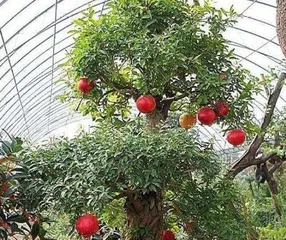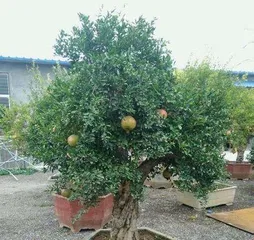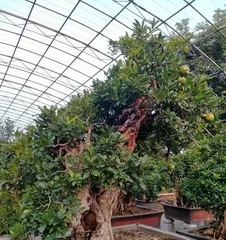The old pomegranate stump is a potted plant with high ornamental value. Its trunk and branches are sturdy, the tree shape is beautiful, the leaves are dark green, the flowering period is long, and the flowers are gorgeous and colorful. However, cultivating an old pomegranate stump also has certain difficulties. If you do not pay attention to maintenance methods and techniques, it may lead to problems such as poor plant growth, slow growth, yellowing leaves, and sterile fruit.

Selecting an Old Pomegranate Stump
When selecting an old pomegranate stump, choose a plant with sturdy trunk and branches, a beautiful tree shape, and dark green leaves. Also, select a variety that is growing well to achieve better ornamental effects.
Cultivation Soil for Old Pomegranate Stumps
Old pomegranate stumps prefer to grow in well-drained, fertile, and loose soil. If the cultivation soil is too compact or lacks nutrients, it can easily lead to slow growth or the occurrence of pests and diseases.

Watering Old Pomegranate Stumps
Old pomegranate stumps have strict water requirements. Generally, the soil should be kept slightly moist but not too wet to avoid root rot. During the high temperatures of summer, the frequency of watering needs to be increased appropriately, but avoid watering excessively.
Lighting for Old Pomegranate Stumps
Old pomegranate stumps love a sunny environment, so in daily care, it is necessary to ensure they receive sufficient sunlight. However, during the high temperatures of summer, attention should be paid to protecting the old pomegranate stump from strong sunlight, which can cause the leaves to dry out.
Fertilizing Old Pomegranate Stumps
Old pomegranate stumps are heavy feeders and have a high demand for fertilizer. During the peak growing season, the frequency and amount of fertilization should be increased appropriately, and it is also important to choose the right type of fertilizer suitable for them.

Pruning Old Pomegranate Stumps
Pruning old pomegranate stumps can promote branching growth, but it is necessary to choose the right time for pruning based on the growth status of the stump. Generally, pruning is most effective during the vigorous growth period in spring.
Disease Prevention and Control for Old Pomegranate Stumps
Old pomegranate stumps are susceptible to certain diseases and pests, such as leaf spot disease and aphids. Therefore, in daily care, attention should be paid to prevention and control measures, and harmful organisms should be discovered and dealt with in a timely manner.
Transplanting Old Pomegranate Stumps
The transplanting of old pomegranate stumps is generally done in spring or autumn. However, before transplanting, it is necessary to water thoroughly to ensure the root system is intact. At the same time, attention should also be paid to choosing a suitable pot and cultivation soil.
Insulation Measures for Old Pomegranate Stumps
In the cold winter, it is necessary to take good insulation measures for the old pomegranate stump to prevent excessively cold temperatures from affecting its growth and development.
Flowering Period Management for Old Pomegranate Stumps
The flowering period of old pomegranate stumps is relatively long, but after the flowering period, it is necessary to appropriately remove the flower buds to avoid affecting its growth and development, which also helps to promote branching growth.
Pest and Disease Control for Old Pomegranate Stumps
During their growth process, old pomegranate stumps are easily attacked by some pests and diseases, such as aphids and powdery mildew. Therefore, it is necessary to take effective prevention and control measures and to discover and deal with harmful organisms in a timely manner.
Root System Management for Old Pomegranate Stumps
The root system management of old pomegranate stumps is very important. It is necessary to regularly change the soil and prune the roots to ensure their good growth and development.
Suitable Temperature for Old Pomegranate Stumps
Old pomegranate stumps prefer a suitable temperature environment. Their ideal growth temperature is between 18°C and 25°C, and it is also necessary to avoid high and low-temperature environments.
Rustic Style Cultivation of Old Pomegranate Stumps
Old pomegranate stumps can be combined with other plants to create a rustic-style cultivation environment. For example, pairing them with potted chrysanthemums or cacti can create a unique and charming cultivation atmosphere.
Nutritional Pruning for Old Pomegranate Stumps
Nutritional pruning for old pomegranate stumps refers to pruning done during the vigorous growth period, which can promote branching growth and ensure the healthy growth of the plant.
Caring for an old pomegranate stump is a meticulous and complex process. To make an old pomegranate stump grow better, scientific cultivation techniques and methods must be adopted. It is hoped that the maintenance methods and techniques introduced in this article can provide some help and guidance to enthusiasts of old pomegranate stumps, allowing them to gain more joy and results in the process of care.